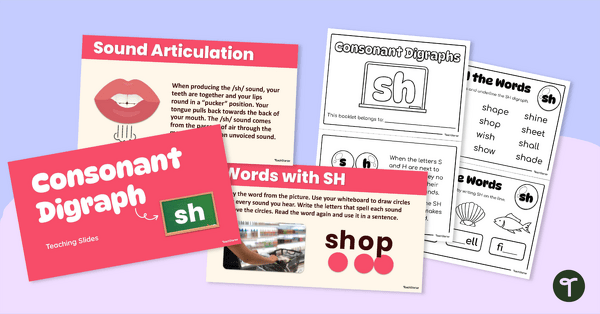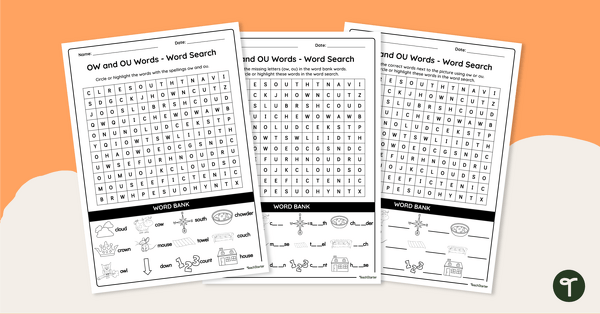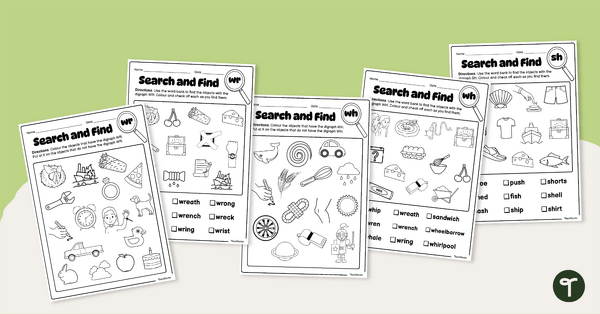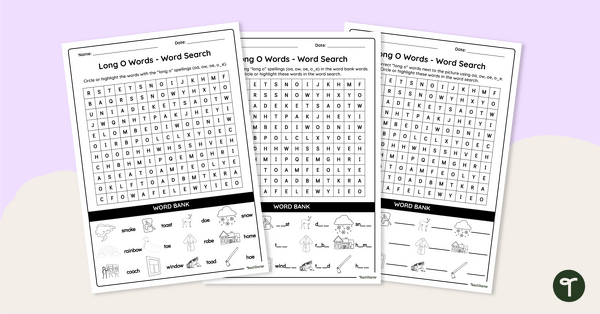Digraphs Teaching Resources
Explore digraph worksheets, learning games and more phonics teaching resources created by teachers for teachers like you!
This collection of printable and digital digraph teacher resources is aligned with the Australian English curriculum and included everything you need to build your lesson plans. You'll find easily editable options, created by our teacher team so that you can easily differentiate instruction.
Are you new to teaching early literacy? Or are you looking for a refresher? Read on for a digraphs primer from our teacher team!
What Is a Digraph?
If you're teaching phonological awareness or reading, you'll need to know! A digraph is a building block of literacy for any young reader.
But how do you teach digraphs in phonics? And what is a consonant digraph?
Digraph Definition
To really answer the question 'what is a digraph,' it's worth going back to the word origin.The word digraph dates back to the 1700s, and it's built from the roots di- (meaning twice) and -graph (meaning something written).
By definition, a digraph is the term used to describe two consecutive letters that work together to make one sound.
If you want to get technical, digraphs are a kind of grapheme — a word that refers to any unit (such as a letter or group of letters) in a writing system. In this case, graphemes are letters or groups of letters in English.
Making sense? We've got one more important phonics term for you! The English language is comprised of about 44 phonemes (the word for the individual speech sounds that make up words). Phonemes can be written in more than 200 letter combinations known as — you guessed it — graphemes and digraphs!
What Are the Most Common Digraphs in the English Language?
Digraphs are often taught in order, starting with those most commonly appearing in English words. Here are some common digraph examples students will encounter:
- ch (as in chin),
- ch (as in school),
- ng (as in sing),
- ph (as in phone),
- sh (as in ship),
- th (as is think),
- wh (as is wheel)
What Is the Difference Between a Digraph and a Blend?
Have you heard the terms digraph and blend thrown around? They seem like they'd be the same thing, but don't be deceived!
While they look the same, there is a major difference between a digraph and a blend. A digraph is defined as two letters that make a single sound. The blend is a combination of letters whose sounds are linked together, but not combined when forming a word. The blend stands apart because its letters still make two distinct sounds.
For example, the 'sl' combination in 'sleep' is a blend, rather than a digraph. That is because you still pronounce the /s/ and /l/ sounds when pronouncing the word.
Another difference between a digraph and a blend is that a digraph can be made up of two consonants or two vowels, while blends are only made up of consonants.
Teaching About Digraphs — Why It's Important
The teaching of phonic digraphs helps students to understand that letter combinations can represent more than one sound and that a syllable must contain a vowel sound.
Teaching students about phonic digraphs in your primaryclassroom will also help them to recognise and associate sounds of the letters of the alphabet, which will help them to improve their reading skills and efficiency.
- Plus Plan

Decodable Text Worksheets – Common Consonant Digraphs (Set 1)
A set of 10 decodable text worksheets for early readers.
- Plus Plan

Decodable Text Worksheets – Common Consonant Digraphs (Set 2)
A set of 10 decodable text worksheets for early readers.
- Plus Plan

Digraph Handwriting - Worksheets
24 digraph worksheets that focus on handwriting and vocabulary activities.
- Plus Plan

AI, AY and A_E Vowel Team Lesson Resource Pack
Introduce students to AI, AY, and A_E vowel digraphs with this set of teaching slides and mini activity book.
- Plus Plan

IE and I_E Vowel Team Lesson Resource Pack
Introduce students to IE and I_E vowel digraphs with this set of teaching slides and mini activity book.
- Plus Plan

Vowel Digraphs Poster Pack
Expose your students to the most common vowel digraphs with this set of 24 posters.
- Free Plan

Diphthongs Worksheets
Practice diphthongs with this set of fun and engaging worksheets.
- Plus Plan

Sh Digraph Lesson Resource Pack
Introduce students to the sh digraph with this set of teaching slides and mini activity book.
- Free Plan

OW and OU Words - Word Search
Explore words containing ‘ow’ and ‘ou’ with this set of differentiated word searches.
- Plus Plan

Vowel Teams Phonics Journal
Help students remember and record words and examples of different vowel digraphs during your phonics lessons.
- Plus Plan

Digraph Search and Find Worksheet Pack
Search for images that contain particular consonant digraphs with this worksheet pack.
- Plus Plan

Consonant Digraph Sound Wall Cards
Guide students through phonics with these consonant digraph sound wall cards for a classroom display.
- Plus Plan

Consonant Digraph Phonics Journal
Help students remember and record words and examples of different consonant digraphs during your phonics lessons.
- Free Plan

Consonant Digraph Cut-and-Paste Worksheets
Reinforce your students' knowledge of digraphs with this set of cut-and-paste worksheets.
- Plus Plan

Long Vowel Digraph Sort Cut-and-Paste
Reinforce your students' knowledge of long vowel digraphs with this set of cut-and-paste worksheets.
- Plus Plan

Th Digraph Lesson Resource Pack
Introduce students to the th digraph with this set of teaching slides and mini activity book.
- Plus Plan

Diphthongs Sound Wall Cards
Use these diphthong cards as visuals on a sound wall or as flashcards during your phonics lessons.
- Plus Plan

OI and OY Words - Word Search
Explore words containing ‘oi’ and ‘oy’ with this set of differentiated word searches.
- Plus Plan

Consonant Digraph TH Interactive Activity
Engage students in practising their learning around the consonant digraph of ‘th’ with this fun sloth-themed interactive activity.
- Free Plan

Th Word List and Flash Cards
Practice reading and spelling words with the Digraph TH with a list of 50 words and accompanying illustrated flash cards.
- Plus Plan

Long O Words - Word Search
Explore words containing some of the most common ‘long o’ graphemes with this set of differentiated word searches.
- Plus Plan

Long A Vowel Digraph Interactive Activity
Practise identifying the different graphemes that spell the long /a/ sound with this fun space-themed interactive activity.
- Plus Plan

Ar Digraph Words With Images
Learn words that contain the 'ar' digraph with these word and picture flashcards.
- Plus Plan

Ng Digraph Lesson Resource Pack
Introduce students to the ng digraph with this set of teaching slides and mini activity book.
- Plus Plan

Vowel Digraph Dominoes - AI and AY
Decode words with vowel team conventions for representing long vowel sounds using this set of 26 dominoes.
- Plus Plan

Long I Words - Word Search
Explore words containing some of the most common ‘long i’ graphemes with this set of differentiated word searches.
- Plus Plan

Long E Graphemes - SCOOT! Task Cards
Explore words containing graphemes that make the ‘long e’ sound with this active classroom game that will get your students moving!
- Plus Plan

Long Vowel Digraph Writing Worksheet
Learn to encode long vowel digraphs with this set of writing worksheets.
- Plus Plan

Consonant Digraph NG Interactive Activity
Engage students in practising their learning around the consonant digraph of ‘ng’ with this fun playground-themed interactive activity.
- Plus Plan

EE, EA and EY Vowel Team Lesson Resource Pack
Introduce students to EE, EA and EY vowel digraphs with this set of teaching slides and mini activity book.
- Plus Plan

Ph Digraph Lesson Resource Pack
Introduce students to the ph digraph with this set of teaching slides and mini activity book.
- Plus Plan

Consonant Digraphs Worksheet Pack
Practise writing and enhancing knowledge of consonant digraphs with this worksheet pack.